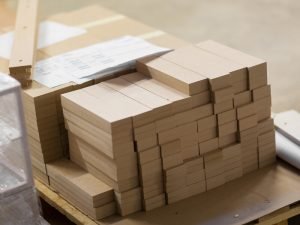Technical field
The invention belongs to the wood-based panel forming process, in particular to the cold-pressing or low-temperature hot-pressing process of marine plywood used for container bottom plate.
Technical background
At present, due to the international logistics industry and the development of the building renovation, a sharp increase in the amount of man-made board, natural primeval forest cloning wood and hard miscellaneous wood is more and more cannot satisfy the demand of the market, so the container floor market appeared with rich resources of the common species of poplar, radiata pine, larch, bamboo, oak and birch artificial fast-growing trees as the base material, Panels and floor boards are still made of cloned wood or hardwood species similar to cloned wood. But these boards according to the conventional container floor production process, the product strength performance can not meet the requirements, and because of the density of different tree species, physical characteristics, PH value, veneer thickness size is not uniform, glue content is not equal, veneer moisture content is not equal, in the production process of quality instability is easy to cause bubbling, degumming. Therefore, in order to solve this problem, according to the characteristics of various wood, using special new production methods, can ensure the quality of the product, meet the quality requirements of composite panels, and reduce the production cost.
Traditional container floor manufacturing technology is to use multilayer hot-press hot-pressing molding process, the thickness tolerance is big, after general type also must pass through a thick sanding process, but due to some large thickness tolerance, after sanding thicknessing sanding machine, sand through the face plate of LVL, cause waste, need to cover processing, namely the second hot press molding. And the traditional artificial board adhesive is to use water-soluble phenolic resin adhesive or other modified adhesive or melamine adhesive, generally need to go through the hot press between 125 ~ 140°C high temperature hot pressing 30-60 minutes. After the above basic adhesive is pressed at the same temperature for a second time, its bonding strength is seriously damaged, resulting in the physical properties of the container floor cannot meet the requirements of the national standard GB/T 19536-2004. In this way, there are many waste products in the wood-based panel process, and the raw materials cannot be fully utilized, resulting in a great waste. The invention content
The invention is to solve the problem that the fixed thickness sanding sand of the container bottom plate penetrates the surface bottom plate, and the hot pressing of the secondary veneer destroys the performance of the adhesive, so that the internal mechanical properties of the substrate, namely the static flexural strength and elastic modulus, are damaged, and provides a molding process for the marine plywood used for the container bottom plate.
The marine plywood forming process for container bottom plate of the invention is characterized in that the substrate is first formed by hot pressing at high temperature and becomes uniform thickness by constant thickness sanding mechanism, and then the surface layer and bottom layer of the substrate are coated with glue respectively and glued to the panel and bottom plate, and then formed by cold pressing process or low temperature hot pressing process.
Among them, the cold pressing process or low temperature hot pressing process, the temperature is less than 60°C, the pressure is 1.2 ~ 1.8mpa, the time is 5 ~ 40 minutes
Epoxy AB glue is used for the surface layer and the bottom layer of the base board in cold pressing process or low temperature hot pressing process, so that the upper and lower layers of the marine plywood used for container floor have better waterproof function and compression resistance.
The marine plywood base plate used for container bottom plate in the invention is made of wooden veneer or bamboo mat, bamboo curtain and bamboo planer separately or mixed, after gluing, spraying and dipping, after overlapping, assembling or directional paving, and then molded by high temperature and high pressure.
The marine plywood used for container floor made by this process does not need high temperature hot pressing when the base plate and the panel and the bottom plate stick together, but can be cold pressing or low temperature hot pressing, so that the internal mechanical properties of the base plate will not be damaged after the second high temperature hot pressing, and the surface of the bottom plate will crack and bubble. Greatly provides the yield, thus also saves the material, to protect the wood resources has a certain significance.
Specific implementation mode
In example 1, clone wood with thickness of 0.8mm, width of 1210mm and length of 2460mm is used as panel and base plate. After gluing, spraying and dipping the wood veneer that has been cut and dried, it is overlaps and formed into a substrate under high temperature and high pressure, and then epoxy AB glue is applied on the bottom and surface of the substrate. Then stick the panel and bottom plate on the upper and lower surface of the wood substrate, enter the cold pressing machine, the temperature of the cold pressing machine is 60°C, the pressure is 1.2mpa, and the pressure is 5 minutes.
In example 2, clone wood with thickness of 0.8mm, length of 2400 circle and width of 1200mm is used as the panel and bottom plate, and bamboo shavings are coated, sprayed and dipped with glue, then overlapped and oriented pavement, and then formed by high temperature and high pressure oriented structural substrate. Apply epoxy resin AB glue on the bottom and surface of the substrate, then paste the panel and bottom plate on the upper and lower surfaces of the bamboo oriented structure substrate, enter the cold press, the cold press temperature is 50°C, the pressure is 1,8 mpa, and the pressure is 40 minutes.

